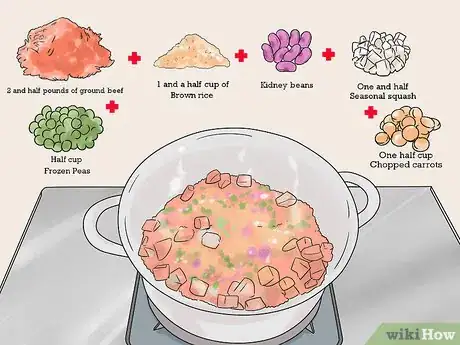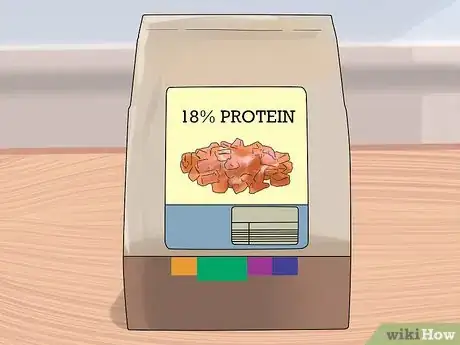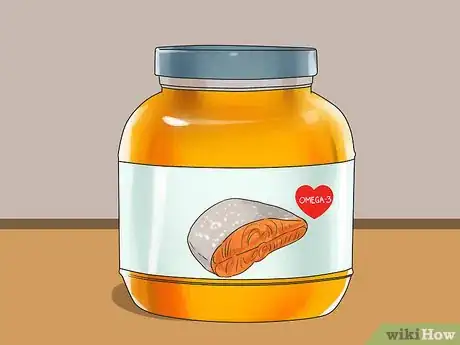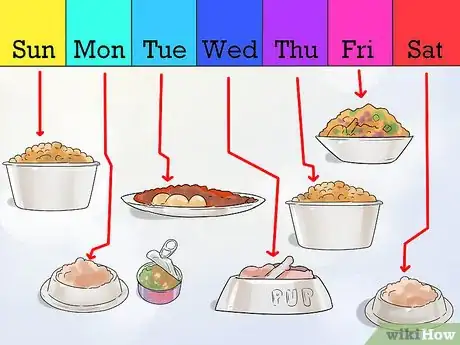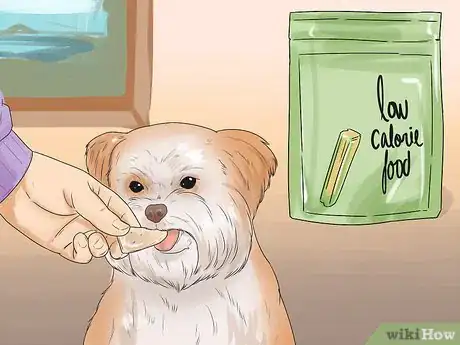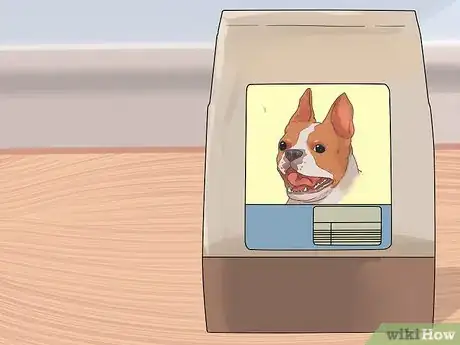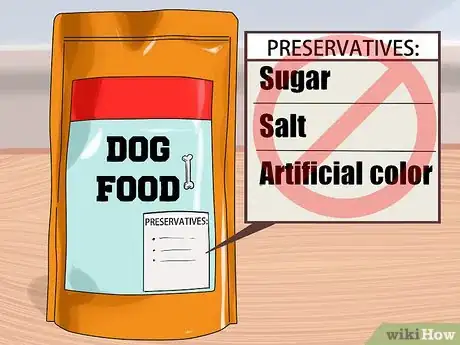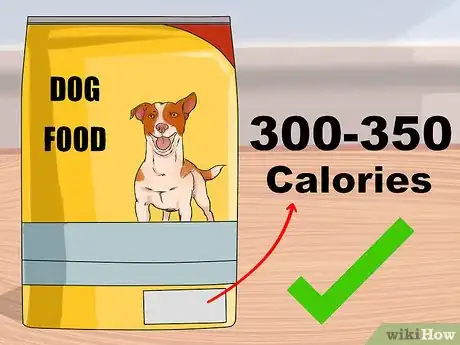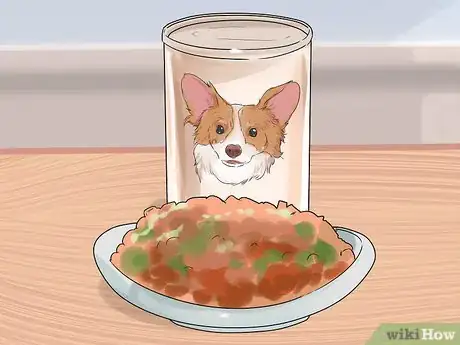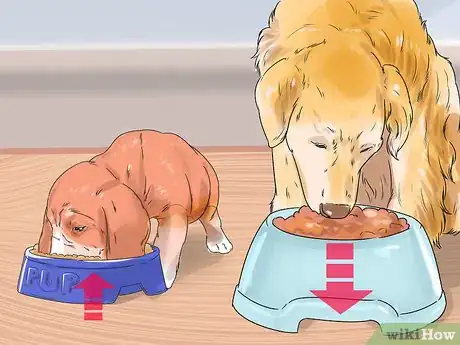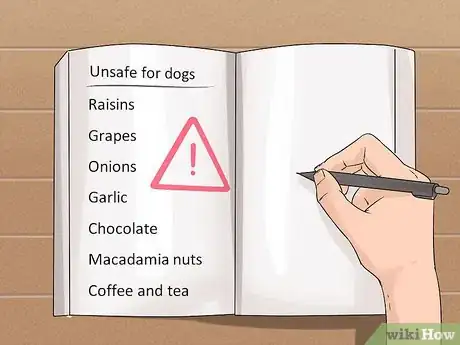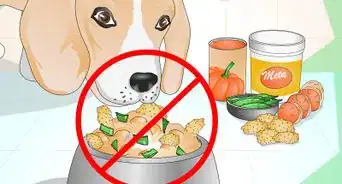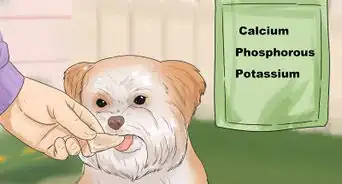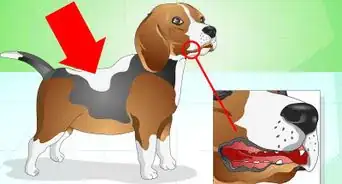This article was co-authored by Brian Bourquin, DVM. Brian Bourquin, better known as “Dr. B” to his clients, is a Veterinarian and the Owner of Boston Veterinary Clinic, a pet health care and veterinary clinic with three locations, South End/Bay Village, the Seaport, and Brookline, Massachusetts. Boston Veterinary Clinic specializes in primary veterinary care, including wellness and preventative care, sick and emergency care, soft-tissue surgery, dentistry. The clinic also provides specialty services in behavior, nutrition, and alternative pain management therapies using acupuncture, and therapeutic laser treatments. Boston Veterinary Clinic is an AAHA (American Animal Hospital Association) accredited hospital and Boston’s first Fear Free Certified Clinic. Brian has over 19 years of veterinary experience and earned his Doctor of Veterinary Medicine from Cornell University.
There are 8 references cited in this article, which can be found at the bottom of the page.
This article has been viewed 87,603 times.
If you’ve heard the old adage, “You are what you eat,” you probably already know that this means the foods we consume provide the nutrients our bodies need for optimal function. This is also true for your dog. Many dog owners have taken an interest in preparing fresh, healthy meals for their dogs as a way to improve their health, but it is important to consult a veterinary nutritionist before you start. Dogs require a careful balance of vitamins and minerals to ensure that they stay in good health, and homemade dog food may be lacking in some of these nutrients. If you don’t want to cook for your pet, there are also a number of healthier, naturally derived dog foods you can purchase.
Steps
Preparing Meals for Your Dog
-
1Consult a veterinary nutritionist first. Before you dive into cooking for your dog, it is essential that you talk with your dog's veterinarian and ask for a referral to a veterinary nutritionist for advice. A veterinary nutritionist can help you to understand your dog's nutritional needs and develop a healthy diet for your dog.
- Do not begin cooking for your dog without consulting a veterinary nutritionist first! This may be detrimental to your dog's health. For example, dogs can easily develop weak bones and teeth if they do not get the proper ratio of calcium phosphate in their food.
-
2Cook easy meals for your dog. This may sound time consuming or difficult, but there are a number of quick, easy recipes you can use to ensure your dog gets all the nutrients it needs from safe, natural sources. Remember to talk to a veterinary nutritionist before you start preparing your dog's meals. It is important to ensure that you are preparing meals that include the proper ratios of nutrients.
- A quick, easy option that you can discuss with a veterinary nutritionist is a beef stew. You’ll need a pound of stew meat, a sweet potato, and half a cup each of diced carrots, diced green beans, flour, and water or vegetable oil. Cook the stew meat and sweet potato in advance. Then, combine the cooked items with the uncooked in a pot. Simmer on medium low heat until carrots are soft. Makes about four servings of one cup each.
- Beef and rice is a recipe that provides a larger quantity of food at a lower cost. You’ll need two and half pounds of ground beef, one and half cups of brown rice, one fifteen ounce can of drained and rinsed kidney beans, one and half cup of chopped seasonal squash, one and a half cups of chopped carrots, and half a cup of frozen peas. Stir all ingredients together with about four cups of water. Cook in a crockpot on low heat for about five hours or high heat for two. Provides eleven one cup servings.
- You can also make snacks for your dog. Chicken jerky is a great option. Slice boneless, skinless chicken breasts into strips that are an eighth of an inch thick. Then, bake for two hours at 200 degrees.
- Always cool food to room temperature or lower before serving it to your dog.[1]
Advertisement -
3Prepare and freeze meals. Save even more time on meal prep by cooking several weeks or even months’ worth of food at one time. Then, portion the meals out and store them in the refrigerator or freezer. Date everything you make, and only thaw a week’s worth of food at a time. A good rule of thumb is to store enough meals for one month in the freezer and enough for a week in the refrigerator.[2]
-
4Use appropriate quantities of necessary nutrients. Not every meal you eat has exactly the right proportion of nutrients, but over time, we consume what we need from a variety of sources or supplements. Your dog’s nutritional needs are the same. They may not get every nutrient they need from every single meal, but you can help them meet all of their nutritional needs over time, if you understand what nutrients they need in what quantities.
- Quality protein should make up at least 18% of an adult dog’s diet.
- Fats should comprise at least 5% of the dog’s diet.
- Additionally, linoleic acid, calcium, phosphorus, potassium, sodium, and vitamins should make up at least an additional 5% of the dog’s nutrition.
- The remaining 70 to 75% of the dog’s nutrition should include water, healthy sources of fiber, minerals, and carbohydrates.[3]
-
5Add oils, herbs, and supplements. If you take a multivitamin every day, fish oil supplements, or glucosamine for your joints, you know how effective and beneficial nutritional supplements can be for maintain optimal health. Your dog can also benefit from the addition of nutritional supplements to their daily meals. You may want to include and rotate a variety of oils, herbs, and supplements, to help balance your pup’s diet. Typically, you’ll only want to add a very small amount of these supplements, and while the initial investment can be substantial, the supplements will usually last for many months.
- Oils provide healthy omega-3 and omega-6 fatty acids that help immune function and digestion. You may want to include fish oil, cod liver oil specifically, or plant oils.
- Calcium is especially important as dogs are growing, but a good rule of thumb is to include about 1000 mg of calcium per pound of food. This can be added with a supplement or by grinding non-treated egg shells.
- Your dog also needs vitamins A, D, and E as well as appropriate amounts of Iodine and phosphorous. Look into the vitamin content of your oils, and supplement these vitamins and minerals as necessary. Most vitamins need to be included in very minimal amounts, so read supplement instructions carefully and talk to your veterinarian for additional guidance.[4]
-
6Vary your dog’s meals. You wouldn’t want to eat the same thing every day, and your dog appreciates variety in their foods too. Feel free to switch it up. Adding in different types of meat is an easy way to do this. Substitute ground turkey for ground beef, and feed your pet fish once or twice a week.[5]
-
7Consider having fasting days. In the wild, dogs eat mainly meat, and they have to hunt for their foods. This means they go through periods of satiation and periods of fasting. This is healthy. Enzymes in the stomach are a necessary part of digestion. However, they are also what fuels your pet’s immune system, so allowing a break from constant food digestion may actually be beneficial to your pet. Only fast one day a week or every other week, and make sure your dog has plenty of water on these days.
- You can give your pup a few low calorie treats throughout the fasting day.
- Do not fast puppies, pregnant or lactating mothers, or older dogs as this lack of nutrients can be harmful in these developmental stages.
Buying Pet Foods in the Store
-
1Check the label for recognizable ingredients. You want to find natural foods for your pet that are created from real meat, vegetables, grains, vitamins, and minerals rather than just a variety of preservatives and chemicals. If you can read the ingredient list without a dictionary, chances are the food is healthy and nutritious.[6]
- Look for labels that say the food is “fit for human consumption.” If you can’t eat your dog’s food safely, it is much more likely to harm your dog’s digestive system.
-
2Learn to read the nutrition label. Many advertisements tout meat as the first ingredient, but this doesn’t always mean that your pet will receive high quality protein. In some cases, this may not even mean your dog is receiving more meat. Ingredient lists on nutrition labels are ordered by the weight of each ingredient as it is added to the recipe. Once cooked, this weight can change, so these lists can be misleading. In order to select a pet food with the best quality, natural ingredient, you'll need to understand how to accurately read these ingredient lists.
- Check for the percentages of protein, fat, and other nutrients in addition to reading the ingredient list.
- Different foods may offer the same amounts of key nutrients, but they can vary dramatically in price. This is generally because the more affordable foods use lower quality protein sources. Purchase the best quality food you can afford.[7]
-
3Avoid certain preservatives and fillers. This can include salt, sugar, artificial colors, and added flavoring. These unnatural nutrient sources do not add to your dog’s nutrition in any way, but they are designed to make the food last longer without spoiling, look more appealing, or taste more like foods that your pet enjoys. While some dogs never show signs of digestive or other health concerns caused by consuming these unnatural food additives, others show significant negative response like decreased energy and elevated risk for diseases common among their breed.[8]
-
4Count the calories. This is especially important as your dog ages or for younger dogs who are less active. Many prepackaged pet foods, even natural ones, include large amounts of sugar that make the food very high in calories without increasing nutritional value. In order to feed your pup the right number of calories, you’ll have to feed them a less than satisfying amount of food. Ideally, your dog’s food should be between 300 and 350 calories per cup, but most store bought pet foods are between 400 and 500 calories (or more) per cup. Count calories to make sure you’re not overfeeding.[9]
-
5Talk to your vet or pet food supplier. Most major, commercial pet foods, canned, dry, or refrigerated, are manufactured months before they reach the store. This means they’re high in preservatives that can decrease the nutritional value. However, many pet stores offer natural foods prepared in smaller batches or by local pet food manufacturers that have a much shorter shelf life because they use fewer preservatives. You can also purchase these more naturally derived foods from online directly from the manufacturer. Talk to your veterinarian or local pet store to get recommendations for natural, preservative free, and locally sourced dog foods.
-
6Include additives with store bought foods. If you want to naturally boost the nutrition of any type of dog food, include some nutritional extras with every meal. Canned meats like chicken and salmon can dramatically improve your pup’s protein and vitamin intake when mixed with store bought food. Another great, low fat treat that packs a heavy vitamin punch is canned pumpkin. Add a few scoops to your dog’s meal once or twice a week to boost digestive function and deliver a number of necessary vitamins and minerals.[10]
Understanding Dog Nutrition
-
1Develop a feeding routine. It’s rarely advisable to leave large amounts of food out for your dog to eat throughout the day, but naturally derived foods have the added concern that the meal will rot. Typically, adult dogs need to be given food weighing two to three percent of the ideal weight for their breed split between two feedings a day.[11] If you have an active dog, you may want to feed them more or higher calorie food, and for your “couch potato” pup, less is more.[12]
-
2Find out about breed-specific health requirements. Most dogs need about the same amount of key nutrients. However, certain breeds need higher or lower levels of nutrients than others. For instance, large dogs are prone to joint and muscle issues, so low calorie foods to keep them at a healthy weight are essential. Additionally, foods that include inflammation reducing, joint health supporting supplements like glucosamine and chondroitin may be a good option.
- Ask your veterinarian if there are any breed-specific nutritional requirements you should know about.
- Find information online about your dog’s breed, and use that to make a more informed dog food purchase or to make a well-rounded meal at home.[13]
-
3Learn how age affects your dog’s food needs. If your dog has just been weaned, you’ll need to feed them specially formulated puppy foods and feed them much more frequently than adult dogs. For senior dogs, those who are age seven and up, the converse is true. They will need far fewer calories, and may only eat once a day. Pregnant or nursing dogs will need to eat higher calorie foods, and may need to eat more frequently. Typical adult dogs should be fed a low calorie, high protein diet twice a day.
- Puppies need to take in food equivalent to two to three percent of their ideal adult weight, and they need to be fed four to six times a day in the first six months.
- From six months to a year, continue to feed them the same quantity of food and gradually reduce feeding times to twice a day.
- By one year, your puppy should be ready for adult food and feeding guidelines. Continue to offer them the same quantity of food (two to three percent of ideal body weight) over two feedings.
- From age and seven and up, reduce the calorie content of your dog’s food and consider adding more supplements that support immune function and joint health include prebiotics and glucosamine.[14]
-
4Keep a list of foods that are unsafe for dog consumption. While most foods that are fit for humans to eat can be digested by dogs, there are some that will make your pup sick. These foods include raisins, grapes, onions, garlic, chocolate, macadamia nuts, coffee, and tea. Talk to your veterinarian about other foods that may be harmful, and make sure you exclude these from your pup’s diet.[15]
References
- ↑ https://www.caninejournal.com/homemade-dog-food-recipes/
- ↑ https://www.caninejournal.com/homemade-dog-food-recipes/
- ↑ http://www.vcahospitals.com/main/pet-health-information/article/animal-health/nutrition-general-feeding-guidelines-for-dogs/6491
- ↑ http://www.whole-dog-journal.com/issues/15_7/features/Home-Prepared-Dog-Food-Nutritional-Information_20568-1.html
- ↑ http://thebark.com/content/how-and-why-cook-your-dogs-food
- ↑ http://thebark.com/content/save-money-homemade-dog-food
- ↑ http://thebark.com/content/save-money-homemade-dog-food
- ↑ http://thebark.com/content/save-money-homemade-dog-food
- ↑ http://thebark.com/content/save-money-homemade-dog-food
- ↑ http://thebark.com/content/how-and-why-cook-your-dogs-food
- ↑ http://www.dogsnaturallymagazine.com/raw-feeding-primer/
- ↑ http://www.vcahospitals.com/main/pet-health-information/article/animal-health/nutrition-general-feeding-guidelines-for-dogs/6491
- ↑ http://dogfood.guru/breed/
- ↑ http://www.vcahospitals.com/main/pet-health-information/article/animal-health/nutrition-general-feeding-guidelines-for-dogs/6491
- ↑ http://thebark.com/content/save-money-homemade-dog-food
- ↑ Brian Bourquin, DVM. Veterinarian. Expert Interview. 20 December 2019.
